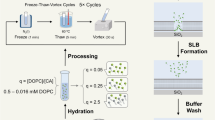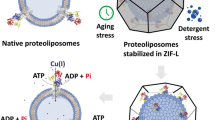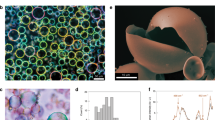Abstract
Cryo-enzymology provides the possibility to develop unconventional biological reactions and detect intermediates in ultrafast enzymatic catalysis processes, but also illuminates the understanding of life principles in extremely cold environments. The scarcity of biological or biomimetic host systems that provide liquid water at subzero temperatures inhibits the prosperity of cryo-enzymology. Here we introduce cryo-enzymatic reactions in subzero water nanoconfined within lipid mesophases formed by conventional lipids. We show that the enzymatic reactions that ensue outperform the homologue catalytic processes run at standard temperatures. We use phytantriol-based lipidic mesophases (LMPs), within which water remains in the liquid state down to −120 °C, and combine crystallization and dynamic studies of the confined water to provide a fundamental understanding of the physical status of water at subzero temperatures, which sets the stage for cryo-enzymatic reactions in these environments. In the model horseradish peroxidase oxidization, the cation free-radical product is stabilized in LMPs at −20 °C, in contrast to the fast-consuming reactions at temperatures above 0 °C. Furthermore, the LMP system also supports the cascade reaction and lipase reaction at subzero temperatures, at which enzymatic reactions with both hydrophilic and hydrophobic substrates are successfully carried out. Our designed LMP system opens access to the nature of confined water in the biomimetic environment and provides a platform for low-temperature biomacromolecule reconstitution and the cryogenic control of enzymatic reactions in bionanotechnology.
This is a preview of subscription content, access via your institution
Access options
Access Nature and 54 other Nature Portfolio journals
Get Nature+, our best-value online-access subscription
$29.99 / 30 days
cancel any time
Subscribe to this journal
Receive 12 print issues and online access
$259.00 per year
only $21.58 per issue
Buy this article
- Purchase on Springer Link
- Instant access to full article PDF
Prices may be subject to local taxes which are calculated during checkout





Similar content being viewed by others
Data availability
All data generated and analysed during this study are included in the article and its Supplementary Information.
References
Rothschild, L. J. & Mancinelli, R. L. Life in extreme environments. Nature 409, 1092–1101 (2001).
Clarke, A. The thermal limits to life on Earth. Int. J. Astrobiol. 13, 141–154 (2014).
Gallat, F. X. et al. A polymer surfactant corona dynamically replaces water in solvent-free protein liquids and ensures macromolecular flexibility and activity. J. Am. Chem. Soc. 134, 13168–13171 (2012).
Franks, F. Biophysics and Biochemistry at Low Temperatures (Cambridge Univ. Press, 1985).
Lazaridis, T. & Karplus, M. Effective energy function for proteins in solution. Proteins 35, 133–152 (1999).
Laage, D., Elsaesser, T. & Hynes, J. T. Water dynamics in the hydration shells of biomolecules. Chem. Rev. 117, 10694–10725 (2017).
Bellissent-Funel, M.-C. et al. Water determines the structure and dynamics of proteins. Chem. Rev. 116, 7673–7697 (2016).
Douzou, P., Sireix, R. & Travers, F. Temporal resolution of individual steps in an enzymic reaction at low temperature. Proc. Natl Acad. Sci. USA 66, 787–792 (1970).
Terefe, N. S., Van Loey, A. & Hendrickx, M. Modelling the kinetics of enzyme-catalysed reactions in frozen systems: the alkaline phosphatase catalysed hydrolysis of di-sodium-p-nitrophenyl phosphate. Food Sci. Technol. Int 5, 335–344 (2004).
Johal, A. R. et al. Sequence-dependent effects of cryoprotectants on the active sites of the human ABO (H) blood group A and B glycosyltransferases. Acta Crystallogr. D 68, 268–276 (2012).
Dai, F., Huang, Y., Zhou, M. & Zhang, G. The influence of cold acclimation on antioxidative enzymes and antioxidants in sensitive and tolerant barley cultivars. Biol. Plant. 53, 257–262 (2009).
Jönsson, Å., Adlercreutz, P. & Mattiasson, B. Effects of subzero temperatures on the kinetics of protease catalyzed dipeptide synthesis in organic media. Biotechnol. Bioeng. 46, 429–436 (1995).
Douzou, P., Keh, E. & Balny, C. Cryoenzymology in aqueous media: micellar solubilized water clusters. Proc. Natl Acad. Sci. USA 76, 681–684 (1979).
Mishima, O. & Stanley, H. E. The relationship between liquid, supercooled and glassy water. Nature 396, 329–335 (1998).
Angell, C. Supercooled water. Annu Rev. Phys. Chem. 34, 593–630 (1983).
Levinger, N. E. Water in confinement. Science 298, 1722–1723 (2002).
Yao, Y. et al. Homogeneous nucleation of ice confined in hollow silica spheres. J. Phys. Chem. B 121, 306–313 (2017).
Gallo, P., Rovere, M. & Spohr, E. Supercooled confined water and the mode coupling crossover temperature. Phys. Rev. Lett. 85, 4317–4320 (2000).
Suzuki, Y. et al. Homogeneous nucleation of predominantly cubic ice confined in nanoporous alumina. Nano Lett. 15, 1987–1992 (2015).
Schreiber, A., Ketelsen, I. & Findenegg, G. H. Melting and freezing of water in ordered mesoporous silica materials. Phys. Chem. Chem. Phys. 3, 1185–1195 (2001).
Findenegg, G. H., Jähnert, S., Akcakayiran, D. & Schreiber, A. Freezing and melting of water confined in silica nanopores. Chemphyschem 9, 2651–2659 (2008).
Yao, Y. et al. Crystallization and dynamics of water confined in model mesoporous silica particles: two ice nuclei and two fractions of water. Langmuir 35, 5890–5901 (2019).
Erickson, H. P. Size and shape of protein molecules at the nanometer level determined by sedimentation, gel filtration, and electron microscopy. Biol. Proced. Online 11, 32–51 (2009).
Hande, V. R. & Chakrabarty, S. Exploration of the presence of bulk-like water in AOT reverse micelles and water-in-oil nanodroplets: the role of charged interfaces, confinement size and properties of water. Phys. Chem. Chem. Phys. 18, 21767–21779 (2016).
Venables, D. S., Huang, K. & Schmuttenmaer, C. A. Effect of reverse micelle size on the librational band of confined water and methanol. J. Phys. Chem. B 105, 9132–9138 (2001).
De, T. K. & Maitra, A. Solution behaviour of Aerosol OT in non-polar solvents. Adv. Colloid Interface Sci. 59, 95–193 (1995).
van’t Hag, L., Gras, S. L., Conn, C. E. & Drummond, C. J. Lyotropic liquid crystal engineering moving beyond binary compositional —ordered nanostructured amphiphile self-assembly materials by design. Chem. Soc. Rev. 46, 2705–2731 (2017).
Mezzenga, R. in Self-Assembled Supramolecular Architectures: Lyotropic Liquid Crystals (eds Garti, N., Somasundaran, P & Mezzenga, R.) 1–20 (Wiley, 2012).
Vallooran, J. J. et al. Lipidic cubic phases as a versatile platform for the rapid detection of biomarkers, viruses, bacteria, and parasites. Adv. Funct. Mater. 26, 181–190 (2016).
Zhou, T. et al. Efficient asymmetric synthesis of carbohydrates by aldolase nano-confined in lipidic cubic mesophases. ACS Catal. 8, 5810–5815 (2018).
Zhou, T., Vallooran, J. J. & Mezzenga, R. Supramolecular chirality and crystallization from biocatalytic self-assembly in lipidic cubic mesophases. Nanoscale 11, 5891–5895 (2019).
Sun, W., Vallooran, J. J., Zabara, A. & Mezzenga, R. Controlling enzymatic activity and kinetics in swollen mesophases by physical nano-confinement. Nanoscale 6, 6853–6859 (2014).
Sun, W., Vallooran, J. J. & Mezzenga, R. Enzyme kinetics in liquid crystalline mesophases: size matters, but also topology. Langmuir 31, 4558–4565 (2015).
Manni, L. S. et al. Soft biomimetic nanoconfinement promotes amorphous water over ice. Nat. Nanotechnol. 14, 609–615 (2019).
Lane, L. B. Freezing points of glycerol and its aqueous solutions. Ind. Eng. Chem. Res. 17, 924–924 (1925).
Murata, K. & Tanaka, H. Liquid–liquid transition without macroscopic phase separation in a water–glycerol mixture. Nat. Mater. 11, 436–443 (2012).
Popov, I., Greenbaum, A., Sokolov, A. P. & Feldman, Y. The puzzling first-order phase transition in water–glycerol mixtures. Phys. Chem. Chem. Phys. 17, 18063–18071 (2015).
Gainaru, C. et al. Nuclear-magnetic-resonance measurements reveal the origin of the Debye process in monohydroxy alcohols. Phys. Rev. Lett. 105, 258303 (2010).
Vallooran, J. J., Assenza, S. & Mezzenga, R. Spatiotemporal control of enzyme‐induced crystallization under lyotropic liquid crystal nanoconfinement. Angew. Chem. Int. Ed. 58, 7289–7293 (2019).
Sauer, D. et al. Dynamics of water–alcohol mixtures: insights from nuclear magnetic resonance, broadband dielectric spectroscopy, and triplet solvation dynamics. J. Chem. Phys. 140, 114503 (2014).
Cerveny, S., Mallamace, F., Swenson, J., Vogel, M. & Xu, L. Confined water as model of supercooled water. Chem. Rev. 116, 7608–7625 (2016).
Johari, G. & Whalley, E. The dielectric properties of ice Ih in the range 272–133 K. J. Chem. Phys. 75, 1333–1340 (1981).
Popov, I., Puzenko, A., Khamzin, A. & Feldman, Y. The dynamic crossover in dielectric relaxation behavior of ice Ih. Phys. Chem. Chem. Phys. 17, 1489–1497 (2015).
Shinyashiki, N. et al. Glass transitions in aqueous solutions of protein (bovine serum albumin). J. Phys. Chem. B 113, 14448–14456 (2009).
Moore, E. B., De La Llave, E., Welke, K., Scherlis, D. A. & Molinero, V. Freezing, melting and structure of ice in a hydrophilic nanopore. Phys. Chem. Chem. Phys. 12, 4124–4134 (2010).
Helfrich, W. Elastic properties of lipid bilayers: theory and possible experiments. Z. Naturforsch. C 28, 693–703 (1973).
Josephy, P. D., Eling, T. & Mason, R. P. The horseradish peroxidase-catalyzed oxidation of 3,5,3′,5′-tetramethylbenzidine. Free radical and charge-transfer complex intermediates. J. Biol. Chem. 257, 3669–3675 (1982).
Kremer, F. & Schönhals, A. Broadband Dielectric Spectroscopy (Springer Science & Business Media, 2002).
Acknowledgements
We acknowledge M. Strach at the Chalmers Materials Analysis Laboratory (CMAL) for the performance of the in situ low-temperature X-ray measurements. We thank V. Lutz Bueno for the coordination of the X-ray experiments. We thank H.-J. Butt, A. Best, C.-H. Tu and P. Räder from the Max-Planck Institute for Polymer Research for the excellent support in the DSC and BDS experiments. R.M. acknowledges support from SNF grants 200020_178997. T.Z. acknowledges the China Scholarship Council for financial support.
Author information
Authors and Affiliations
Contributions
R.M., Y.Y. and T.Z. conceived the idea, planned the experiments, wrote the paper and coordinated the overall research project. Y.Y. and T.Z. discovered the LMP at subzero temperatures. Y.Y. developed methods to study the crystallization and dynamics of water, performed the DSC and BDS experiments, analysed and interpreted the DSC and BDS data and coordinated the WAXS experiments. T.Z. produced the LMPs, performed the SAXS experiments, designed and performed the cryo-enzymatic reactions and performed the ultraviolet experiments. G.F. contributed to the analysis and interpretation of the BDS data. R.F. and U.G. coordinated the BDS experiments. All the authors discussed the results, provided comments and revised the manuscript.
Corresponding author
Ethics declarations
Competing interests
The authors declare no competing interests.
Additional information
Peer review information Nature Nanotechnology thanks Renata Bilewicz, Yi-Tao Long and other, anonymous, reviewer(s) for their contribution to the peer review of this work.
Publisher’s note Springer Nature remains neutral with regard to jurisdictional claims in published maps and institutional affiliations.
Supplementary information
Supplementary Information
Supplementary Figs. 1–13, and description on the fitting procedure of dielectric spectra.
Rights and permissions
About this article
Cite this article
Yao, Y., Zhou, T., Färber, R. et al. Designing cryo-enzymatic reactions in subzero liquid water by lipidic mesophase nanoconfinement. Nat. Nanotechnol. 16, 802–810 (2021). https://doi.org/10.1038/s41565-021-00893-5
Received:
Accepted:
Published:
Issue Date:
DOI: https://doi.org/10.1038/s41565-021-00893-5



